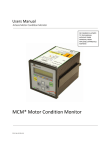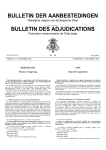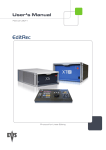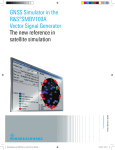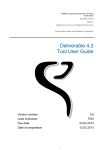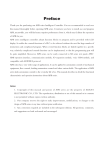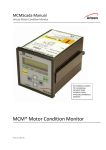Download Paper Multiple Technology Tag
Transcript
Multiple Technology Tag For Seamless Localization Roel Van Hoylandt, Bob Claerhout, Tim Denis, Charles Vercauteren, Maarten Weyn. Abstract—The goal of this research is to design a battery powered electronic device that can be used in Real Time Locating Systems. The device should be well equipped so it can be used for tracking persons and objects based on received signal strengths values from Wi-Fi and GSM networks. GPS-based tracking is also made possible. Every smart-phone is equipped with hardware for these requirements. The hardware on smart phones however, is not optimized for low energy consumption during continuous localization. For this reason they’re not suited for long-term continuous use. This paper introduces a working hardware design and explains the used program structure. In addition, the power consumption of the circuit is also explained. The multiple technology tag is designed and programmed in function of low energy consumption, for a maximum up-time on a single battery-charge. A battery life time of more than 61 days can be reached when only Wi-Fi is used, and when the location is updated every two minutes. Repeating a sequence of updating the location ten times using only Wi-Fi, updating once using only GSM and updating once using GSM and GPS, can be done for more than 18 days. This can only be maintained when a sleep time of two minutes is used after each location update. Index Terms—Multiple Technology Tag, Wi-Fi, GPS, GPRS, GSM, Battery powered, RSSI, RTLS, Localization F 1 I NTRODUCTION At present, many objects in our environment are connected in some way to computer-based technology. In the near future, it is likely that the need for computerintegration will rise to even higher levels. One of the shortcomings in the total integration between environment, humans and computer-based technologies is the localization of people and objects. Nowadays, there are already a number of localization technologies (based on GPS, Wi-Fi, GSM, UWB, etc.) [6] which perform well, but they all have one problem: they only work when they are used in a specific environment or application (e.g. GPS only works when enough satellites are detected). The goal of ”the Multiple Technology Tag” is to combine existing technologies and create a device that can locate people and objects in any given environment. The tag is designed to automatically switch to other technologies when changing from one environment to another. While moving indoors, it could be possible that the tag switches from GPS localization to Wi-Fi localization for tracking and from GPRS to Wi-Fi for communication with the server. If the tag is unable to receive a valid GPS-signal, the tag can make use of the received signal strengths from GSM base stations. This data can also be used to calculate the coarse position of Roel Van Hoylandt, Charles Vercauteren and Maarten Weyn are with Artesis University College Antwerp, dept. of Applied Engineering: Electronics-ICT, Paardenmarkt 92, B-2000 Antwerpen, Belgium. E-mail: [email protected], [email protected] and [email protected] Bob Claerhout and Tim Denis are with AtSharp, BVBA Kromstraat 64C/9B, 2520 Ranst, Belgium. E-mail: see http://www.atsharp.com/ the tag [6]. In Section 2 the hardware design of the tag is explained. Section 3 discusses different ways to do localization and data transmissions. The software design is explained in Section 4. Section 5 contains information about the power consumption used by the different modules and circuits. Some use cases and other possibilities with the same hardware are listed in Section 6. The conclusion over the multi technology tag can be found in Section 7. 2 H ARDWARE D ESIGN An overview of the hardware can be seen in the block diagram on Figure 1. The Wi-Fi module is used as main controller, it is connected with the GPS and GSM module via UART. It is also connected to multiple sensors (e.g. motion sensor and push button). Three LEDs and some Fig. 1. Hardware Block Diagram control lines for the GPS and GSM module are connected as normal GPIO. A Li-Po battery powers the GPS module and the 3.3 voltage step down converter. The battery voltage is measured by the Wi-Fi module via a sensor input. The GSM and Wi-Fi module are powered via the 3.3 voltage step down convertor. 2.1 Battery and Battery Charger 2.1.1 Battery Type The tag uses a rechargeable battery for powering the circuits. To increase the time between two battery recharges, power consumption is one of the major design issues. Good design starts with finding components which are energy efficient. A battery with a high energy density is used so the physical dimensions can be small. In this design a Lithium-Ion Polymer battery is used. The battery has a nominal capacity of 1300 mAh and an output voltage between 3.0 Volt and 4.2 Volt. 2.1.2 Battery Charger To charge the battery, we implemented a charger in the tag. Because we use a Lithium-Ion Polymer battery, a specific charger is needed. The MCP73833 is an Integrated Circuit (IC) with an Lithium-Ion and Lithium-Ion Polymer charger inside. This IC is a good choice because it makes it possible to charge the battery by using 5 Volt (e.g. an USB-port). Another advantage of this IC is that it needs a low number of external components. Figure 2 shows the circuit arround the MCP73833. In the prototype of the tag two LEDs are integrated. A green LED lights up when the battery is fully charged, the yellow LED lights up when the battery is charging. A 10 kΩ resistor (R3 ) is used to limit the charge current to a maximum of 100 mA [1] . This value is chosen so that from such a battery can be as high as 4.2 Volt. A voltage regulator is implemented on the tag. Figure 3 shows the circuit of this step down converter. Fig. 3. 3.3 Volt Step Down Converter The voltage reduction is realized using a TPS62291DRV IC. It can handle currents with a maximum of 1 A. JP1 (see Figure 3) can be used for powering external circuits. The TPS62291DRV is a DC/DC converter and switches at a fixed frequency of 2.25 MHz. At light load it enters a power save mode. The device uses 15 µA when there is no output current. With a battery voltage between 3.8 Volt and 4.2 Volt an efficiency from 90 % or more can be reached for currents higher than 0.6 mA [2]. 2.3 GPS When the device is placed in a location where no WiFi localization is possible, a GPS receiver can be used when GPS signals can be received. The circuit from the Fig. 2. Battery Charger Circuit it is possible to charge the tag from any standard USB 2.0 port, some motherboards power down the USB port if the current given by the port is to high. Default USB 2.0 ports can also deliver 500mA, but this needs some digital negotiation. To use this feature extra hardware needs to be implemented on the tag. Some batteries have an integrated thermistor. By measuring the resistance of this thermistor, the charger can lower the charge current when the battery becomes too hot. The battery used in our design doesn’t have a thermistor inside so R4 is used to mislead the battery-charger. A resistance of 10 kΩ represents a thermistor at 21◦ C. The battery can not be overcharged, the MCP73833 has an end-of-charge control circuit inside. Also an automatic recharge circuit is implemented in the IC [1]. Fig. 4. A1035-H GPS Receiver 2.2 3.3 Voltage Step Down Converter The Wi-Fi and GPS modules are not designed to be powered directly by a LiPo-Battery. The output voltage GPS receiver is show in Figure 4. The receiver is powered by the 3.3 voltage step down converter. The prototype of ”the Multiple Technology Tag” is equipped with a Fig. 5. GL865 GSM Module, SIM-Card Holder and SiP32411 Load Switch header (JP3 , see Figure 4) which makes it possible to measure the current used by the GPS-receiver. For normal use this header should be shorted electrically. The receiver is connected to a backup-voltage which keeps the internal RTC running this decreases the Time To First Fix (TTFF) after a power-on event. A diode is used to power the backup-circuit of the GPS-receiver because it is also possible to use an ultracap in combination with the A1035-H in applications where no battery is used. This diode protects the charge-circuit inside the GPSModule. For communication with the Wi-Fi-module, two UART lines are used (Tx and Rx ). The header JP4 (see Figure 4) can be used to connect a logic analyzer during debugging. The GPS-module is switched off when it is not used. This is done by the Wi-Fi module, it emits a short positive pulse on the line connected to pin 17 from the GPS module. Sending another pulse switches the module to the on state. 2.4 GSM/GPRS In Figure 5 the circuit of the GL865 GSM-Module is shown. It also contains a SIM-Card Holder and a Load Switch (SiP32411). There are two types of the GL865 module available on the market, the GL865-DUAL and GL865-QUAD. The GL865-DUAL can be used in countries where operators use the 900 MHz and 1800 MHz frequency bands. These are the frequencies used in Europe. The GL865-QUAD can also be used with the 850 MHz and 1900 MHz frequencies but uses a little more power. If the GL865 is in idle-mode it is possible to disconnect it’s power-supply on pin 38. This is not necessary but it will lower the battery-consumption with a current of approx. 630µA [3]. The load switch makes it possible to disconnect and re-connect the power to the GSMmodule by switching a simple enable-signal [4]. This enable-signal is controlled by the Wi-Fi-module. Like the GPS-receiver, the GSM-module also needs a backup voltage. This voltage makes it possible to get a faster connection with the GSM network after a power-on event. JP6 (see Figure 5) is a test-header to measure the current used by the GSM-module. A logic analyser can be placed on header JP5 (see Figure 5) for easy debugging. JP5 is placed on the two UART lines which are used to create a connection between the GSMmodule and Wi-Fi-module. The GSM-module accepts voltages as high as 2.8 Volt on the receiving UART pin. A voltage divider (R6 and R7 in Figure 5) is used to reduce the higher voltage (3.3 Volt) that is placed by the Wi-Fi-module on the Tx line. 2.5 Wi-Fi Figure 6 shows the circuit of the RN-171 Wi-Fi-module. This module is designed for applications where energy consumption is a critical issue. A tilt/motion switch is used to detect movement of the tag. The state of this switch is checked using the current loop sensor inside the Wi-Fi-module [5]. Three LEDs are used for debugging and signalizing, a logic analyzer can be connected to JP8 (see Figure 6). A standard push-button is also integrated on the board. R13 is a pull-up resistor, C17 is used for de-bouncing, R14 is responsible for recharge the debounce-capacitor once the push-button is opened again. JP7 (see Figure 6) is used to measure the current used by the Wi-Fi-module. For communication with the GSM-receiver and GPS-module, two UART communication lines are used. Other lines are used to check the power-state from the GSM-module, control the load switch, and change the power-state from the GPSmodule. For measuring the battery voltage, a voltage divider (R8 and R9 ) is used because the sensor-inputs can only measure voltages up to 400 mV. A 16-pins ISP- Fig. 6. RN-171 Wi-Fi Module, Tilt/Motion Switch, Push-Button,... Fig. 7. Prototype PCB-Design (Top) Fig. 8. Prototype PCB-Design (Bottom) 2.6 connector is used to load the firmware into the Wi-Fimodule. This connector is also used for debugging. The Wi-Fi-module is the most important part of the whole design, it is used as main controller because it is possible to load self-written firmware in the module. The Wi-Fi module is able to go in a sleep state and it can wake up due to an internal timer interrupt. This makes it possible that the module is in a sleep state most of the time to save power. The Wi-Fi module decides when to scan Wi-Fi, when to use GPS localization, when to use GSM localization, etc. This is further explained in Section 4. PCB Design The Printed Circuit Board (PCB) is designed as a twolayer PCB. Standard 0805 and 1206 sized components are used. Through hole components are avoided where possible. Figure 7 shows the top of the prototype. The antennas A1 (see Figure 4) and A2 (see Figure 6) are placed in the corners, with a proper clearance to the ground plane. The battery-connector (JP2 ) (see Figure 7) is placed horizontally to reduce the total thickness of the tag with plugged in cables. The SIM-card holder is placed on top for easy accessibility. The GSM-module is placed at the bottom (see Figure 8). On a subsequent design of the PCB, it is recommended to make use of an micro-SIMcard and a smaller GSM-module. Placing more components at the bottom of the PCB also reduces the size of the tag. The whole circuit, PCB and software is designed to work with varying set-ups. If GPS and GSM are not needed, a cheaper tag can be realized, just by not soldering them on the board. The software detects the absence of these modules and only uses Wi-Fi for localization and communication. Even if the modules, for whatever reason, get broken during normal use, the software will detect this and switch to an alternative localization and data transmission method. 3 L OCALIZATION AND DATA COMMUNICATION The multiple technology tag is designed to work in cooperation with an RTLS server. The RTLS server is used to calculate the position from the tag when Wi-Fi or GSM is used, so no complex localization algorithms need to be implemented on the tag. The communication with the RTLS server is done by sending TCP or UDP packets from the tag to the server. The packages are formatted as described in the locON protocol. The RTLS server is also used to read out the location of the tag. 3.1 Wi-Fi Inside buildings it is usually impossible to receive a proper GPS-signal. This means GPS can’t be used for localization inside a building. A technique used for indoor tracking and localization is to make use of the already installed Wi-Fi access points. Two types of WiFi-based localization principles are used. One principle, called infrastructure based tracking, uses the access points for measuring the RSS from the sending mobile devices. A drawback to this system is the need for communication with the access points. The Real Time Locating System (RTLS) server needs to be connected to the access points to receive the measured data, thus existing infrastructure need to be adapted. Also, not every type of access point available to the market is capable of doing RSS measurements. While the tag is not designed to use this method, the localization of the tag will not be a problem in places where this system is used. This is due to the fact that infrastructurebased technologies can localize every device in range, that periodically sends a Wi-Fi packet. Using the second method, the mobile device does the RSS measurement of the receiving access points. This system can be used in every environment, even in areas where no connection to the access points can be made. Once the mobile device has scanned all the access points in range, it connects with one of them. Once authenticated, the mobile device sends the collected data to the RTLS server using the existing connection. [6]. If no connection can be made to one of the access points, the RSS data can be send over a GPRS connections, this is not yet implemented into the software design. 3.2 GPS When localization using Wi-Fi is not possible due the lack of access points in range, or authentication is not possible, other localization techniques can be used. If GPS signals can be received, the GPS receiver can be used to locate the device. Once the GPS receiver has calculated the position of the tag, this data needs to be sent to the RTLS server. This can be done using the GSM/GPRS module. 3.3 GSM/GPRS If Wi-Fi localization or data communication is not possible, localization and data transmission can be done by using the GSM/GPRS module. For localization by GSM network, the same principle of Wi-Fi localization is used, the module measures the signal strengths of the receiving base stations. However there is small difference, where Wi-Fi scans all 13 channels in 2.6 seconds with a default scan time of 200 ms for each channel, scanning of all receiving base stations can take as much as two minutes. To solve this problem only the neighbouring base stations are scanned. The GSM module receives a message of the serving cell which informs the module about the channel numbers that are used by the neighbouring cells. The module can finish the cell-scan relatively quick, knowing which channels to scan. The drawback is that the scan is limited to a maximum of seven base stations from the serving provider. The GSM/GPRS module can also be used for data communication with the RTLS server. The module only supports GPRS, other data transmission techniques like EDGE, UMTS and HSDPA are not supported. Because the data-packets that need to be send are really small, high transmission speed protocols are not necessary. 4 SOFTWARE DESIGN The firmware, which is loaded into the Wi-Fi module contains an embedded operating system (called eCos) and is compiled for the use on a 32-bit G2C547 chip. The firmware has an application loader which loads self-written applications. The applications are written in C and compiled with the Bare-C Cross-compiler (BCC) [7]. The software application, is split in three major parts. This is done for better energy efficiency, because loading a big program uses more power then loading a small program. The software is designed to minimize the number of reload events. Figure 9 shows the program structure. 4.1 Initialization One program is called ”MTT-Init”, which is the default start-up program. If the battery of the module gets connected, ”MTT-Init” gets loaded. The module receives an power on reset event, this event starts a function which initializes the hardware. The three LEDs blink at an RTLS server, the module creates a locON packet with all the RSS values and mac-addresses of all the Wi-Fi access point in range. Also temperature and battery measurements are included into the packet. The following step is sending the packet to the RTLS-server of the existing Wi-Fi connection. Once this is done the module goes to a sleep mode. After a timer interrupt the module wakes up again and ”MTT-send-WiFi” is loaded again. 4.3 Fig. 9. Program Flow specific pattern which is dependent on the battery voltage, the software checks if the GSM and GPS modules are present and working. The motion sensor also gets initialized. Next, the software tries to associate with an access point. During configuration time, three network names, authentication techniques and passwords can be programmed into the tag, the tag only tries to associate with one of these three access points. If association was possible, it loads the ”MTT-Send-WiFi” software. If no association can be established, the software tries it again for a configurable number of times. Because a short scantime is used to save energy, not every wireless network available is always found by the module, this is the reason why the rescan possibility is included. If the maximum number of rescans is reached the software loads the ”MTT-Send-Gsm” software, the maximum of number of rescans can be changed in a configuration file. 4.2 Wi-Fi localization The second program, ”MTT-Send-WiFi”, is used when Wi-Fi networks are available and association was possible. If no connection can be made with the access point, the software tries it again for a specific number of times. if the maximum number of rescans (which is defined in a configuration file) is reached, the module switches to GPS and/or GSM localization and GSM data transmission. If a connection can be established with the GSM and GPS localization If Wi-Fi is not available, the module switches to GSM and GPS localization. First the program checks if the GPS-module is present, if it is not, the program does a cell monitor. The RSS values and information needed to identify the base stations are put in a locON package together with the results of a temperature and battery measurement. If the GPS-module is available, the program powers it by sending a positive puls on the gps-power-on line. Once the GPS-module is powered on, it sends an NMEA (National Marine Electronics Association) code every second [8]. The GPS-module is configured to only send GGA-messages, this message contains information such as longitude, latitude, MSL-altitude, UTC-time, etc. Because the GSM-module is connected to normal GPIOpins, the hardware UART buffer from the Wi-Fi module can’t be used, to solve this problem, software routines are used. The Wi-Fi module goes to sleep state once an GGAmessage without valid position data is received. After a timer interrupt the device wakes up to receive and decode the next GGA-message. The sleep-time can be configured. The maximum number of wake-ups before switching off the GPS-module can also be set. Once the GPS-module sends a GGA-message containing a valid position, the Wi-Fi modules places this data into a locON packet and sends it to the RTLS-server using a GPRS-connection. If no GGA-message with valid position data can be received after a number of wakeups, the GSM-modules wakes up and a cell-monitor is done. For communication between the GSM-module and WiFi-module, AT-commands are used. 5 5.1 P OWER C ONSUMPTION Wi-Fi Module Table 5.1 shows the average Wi-Fi module currents in different situations, the typical times are given too. To define the typical times, the average time of five tests is calculated. If the tag is used with only the Wi-Fi module soldered on the PCB, a theoretical stand-by time of over five years can be achieved, this is because the voltage regulator and battery voltage divider also uses some current. In reality such a long stand-by time is impossible, because of the self-discharge of the battery. The last row in the tables shows the values when no GPS fix is found after 10 wake-ups with 1800 ms in between. When the GPS and GSM module are not in use, while doing a scan every two minutes, a battery life time of more than 61 days is possible. If the tag is used only during working days, and charges in the weekend, the location can be updated every seven seconds. Situation Sleeping MTT-Init (Power On) MTT-Init MTT-Send-WiFi MTT-Send-GSM(GSM only) MTT-Send-GSM (GSM + GPS) Average Current 3.50 µA 27.817 mA 31.968 mA 32.334 mA 14.194 mA 6.299 mA Typical Time 3.62 s 2.75 s 3.20 s 32.00 s 58.10 s TABLE 1 Power Consumption Wi-Fi Module For example, while using Wi-Fi on a Nokia N97 mobile device and updating every 30 seconds, a battery life time of 40 hours can be reached [9]. Scanning every 30 seconds with the multiple technology tag is possible for periods up to 412 hours. 5.2 GPS Module Table 5.2 shows the current used by the GPS module. A small current is needed to run the internal real time clock, this allows the module to decrease the time to the first fix. During acquisition the Wi-Fi module is powered off most of the time. Situation Sleeping Acquisition Average Current 6.36 µA 24.677 mA Typical Time (Maximum time is configurable) TABLE 2 Power Consumption GPS Module For better TTFF, the software can be extended with code which sends Extended Ephemeris (EE) data to the GPS module. Transfering the 7 day EE data, which has a size of approximately 70 kilobytes of data, from the Wi-Fi module to the GPS module takes a minimum of 30 seconds when using higher baudrates and SiRF commands, instead of NMEA commands. The EE data can be downloaded from the GPS module manufacturers server. This feature is not yet include in the software. 5.3 GSM Module Table 5.3 shows the current used by the GSM module, when the load switch is opened, no current can flow trough it, only a very small current is leaking trough. The second line in the tables shows the average current which is taken while starting up the module, registering to the cellular network, doing a cell monitor, opening a socket to the RTLS server, sending a locON packet to the Situation Off (Load Switch open) Cell monitor and Packet send Average Current 50 nA 42.420 mA Typical Time 29.4 s TABLE 3 Power Consumption GSM Module RTLS server, closing the socket, disconnecting from the cellular network and switching of the module. The GSM module also uses a backup voltage for powering internal circuits. The current running here is rated at 2 µA. 5.4 Voltage Regulator and Battery Voltage Divider If every module is powered off, the battery drain is at minimum. The voltage regulator still uses a current of 15 µA, the voltage regulator can be disabled by pulling the enable line low [2]. In this design this is not done, because the voltage regulator is used to feed the backup circuits and Wi-Fi and GPS modules during sleep. The current flowing trough the voltage divider is as high as 8 µA when the battery is fully charged. The load switch uses less then 1 µA when it is not in use. This results, for a tag with all modules soldered on, to a minimum current of 35,91 µA. 6 OTHER POSSIBILITIES HARDWARE , USE CASES WITH THE SAME The multiple technology tag can be used for many applications. For example, it can be used to track forklifts while they are driving from inside the storage building to the loading docks outside, also the pallets can be tracked from manufacturer to the final warehouse. Another possibility with the same hardware is to build an ultimate fingerprinting device for real time localization systems which can scan Wi-Fi and cellular base stations while using GPS for exact localization. If the tag is given to people that pass every street in the city, like personnel of the postal service, it should be possible to fingerprint a whole city in a couple of days. This requires some changes in the existing software, because it currently isn’t designed for such an application. 7 C ONCLUSION The design of the multiple technology tag as presented in this paper can be used in real-world applications. Although some minor changes can still be made to increase the battery life. When a sleep state of 120 seconds is used after every location update, a battery life time of more than 18 days can be reached while running the following cycle: update the location 10 times while using only the Wi-Fi module, update the location once using only the GSM-module and send the GPS coordinates over GPRS once. The last example assumes that the GPS module finds a fix in under two seconds. The software can be adapted for many situations and it is possible to use no GPS or GSM module. Some adaptable timers and counters are build into the software so the software can be optimized for several specific situations. When placing the tag into a car, Wi-Fi localization is not really important, but for localizing people inside a building, Wi-Fi is the preferred localization technique and GPS is not useful. GSM localization can also be used in the last scenario. All these choices can be made during the configuration of the software, which makes the multiple technology tag a strong tool for real time locating systems. R EFERENCES [1] Microchip, “MCP73833/4 - Stand-Alone Linear Li-Ion / LiPolymer Charge Management Controller,” p. 32, 2009. [2] T. Instruments, “1-A Step Down Converter in 2 x 2 SON Package,” p. 24, 2008. [3] Telit, “GL865 Hardware User Guide,” p. 71, 2011. [4] V. Siliconix, “2 A, 1.2V, Slew Rate Controlled Load Switch,” p. 13, 2011. [5] R. Networks, “WiFly GSX 802.11 b/g Wireless LAN Module,” p. 18, 2012. [6] M. Weyn, “Opportunistic seamless localization,” p. 162, 2011. [7] G. Mircosystems, “G2C547 Programmer’s Reference Manual,” p. 111, 2008. [8] Maestro, “GPS Receiver A1035-H - User’s Manual,” p. 38, 2009. [9] I. Constandache, S. Gaonkar, M. Sayler, R. Choudhury, and L. Cox, “Enloc: Energy-efficient localization for mobile phones,” in INFOCOM 2009, IEEE. IEEE, 2009, pp. 2716–2720.

















